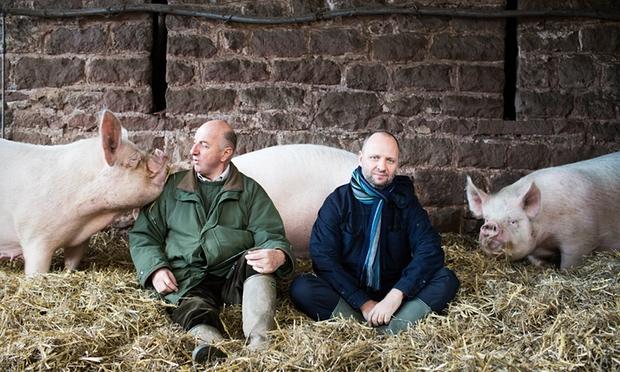By Tom Parker Bowles Event for The Mail on Sunday
24th February 2019
The Whitebrook
Whitebrook, near Monmouth Monmouthshire
Rating:
We come by night, past the ruins of Tintern Abbey, gently lit, and on, up further, climbing and winding through the inky black. This is some of the most stirring country on Earth, all ‘steep woods and lofty cliffs’, ancient and mighty, fecund even in the winter’s depth. Yet Wordsworth’s ‘wild secluded scene’ is shrouded in the deepest dark, and lost in the Monmouthshire gloom. As are we. Sort of. Lost, that is.
Are you sure it’s up here?’ I ask Matthew, panicked by the lack of signal. The satnav has died and more primal instincts take over. ‘Have faith,’ he mutters. ‘I know it’s here somewhere.’ But as the road narrows, so too do our hopes of dinner. Then a flash of pale wood, a sign, The Whitebrook, and a gentle exhortation to turn left. Oh aching joys and dizzy raptures and all that. We’ve arrived. In a car park, under a clear sky and blanket of stars, and the river not so much ‘soft inland murmurs’ as gushing, tumultuous thunder.
Inside, though, all is discreetly quiet, save the low tinkle of jazz. We sit, and sip icy manzanilla sherry, in a low-ceilinged, comfortable room with an old-fashioned feel. It’s here that menus are perused, discussed and ordered before venturing next door. The room fills slowly, decorously, conversations held in muted tones. The sommelier persuades us to choose a cheaper wine, a welcome relief from the usual upsell. And we chew bread, brown or white, nothing fancy, yet just as home-made bread should taste.
Chef proprietor Chris Harrod is modest and softly-spoken and tells of the travails of being up here. ‘It snows and we’re stuck,’ he says with a smile. ‘No one in, no one out.’ The menu is tasting only, yet somehow, we don’t feel enslaved by its usual tyranny. There’s a bowl filled with plump nutty barley, mixed with Barkham Blue and stuff gathered from the local hedges. Tree cabbage? Scurvy grass? God knows. They add verdant, gently bitter crunch, the first shoots of spring.
Roasted Jerusalem artichoke is the very essence of sweet winter, balanced with the creamy, lactic bite of a delicate goat’s curd. The odd crunch of seed, and yet more ‘forest findings’, or foraged bits, add texture and nuance. There’s a handsome scallop, burnished with butter, the interior beautifully opaque. A smooth parsnip purée accentuates the shellfish’s sweetness, while plum pickle provides an acidic whip crack. Harrod’s cooking is technically skilled but unshowy, his understanding of balance sublime.
It wouldn’t be a modern tasting menu without cauliflower, and so it appears, roasted with pickled onion and ramson buds and crisp kale, far greater than the sum of its parts. A taut piece of turbot comes with mussels and purple sprouting, an edible snapshot of the season. The fish is very much the star. Just like the local Ryeland hogget that graze on the banks of the Wye. This is a serious piece of sheep, some of the best I’ve tasted. A pink lozenge of loin, and slow-cooked breast, cut through with a ribbon of fat. And something with the liver too. This beast didn’t die in vain.
Around us the atmosphere gets a little more jovial as glasses are emptied and voices raised. ‘I don’t want to fall in love,’ croons Chris Rea as we devour the famed suckling pig, belly pork with immaculate crackling, a pale pink chop and a crisp cylinder filled with piggy bits. This is subtle, precise, intelligent cooking that gives one an absolute sense of place. With no need to shout or swagger. We finish with pudding, poached pears with buttermilk. And blackcurrant granita with camomile. Eight courses, yet we don’t feel stuffed. The lights are now low, the room suffused in well-fed bonhomie. Outside, the Wye rumbles on.

 JOIN US FOR THE FIRST OF OUR EXCLUSIVE PRIVATE FEASTS
JOIN US FOR THE FIRST OF OUR EXCLUSIVE PRIVATE FEASTS






 Described by Jamie Oliver as the “Oscars of the food world”, the awards were created in 2000 to celebrate the people and organisations that produce and promote the best of British food.
Described by Jamie Oliver as the “Oscars of the food world”, the awards were created in 2000 to celebrate the people and organisations that produce and promote the best of British food.
 I get my Longhorn beef aged for 33 days and my Middle White pigs – the best crackling this side of heaven with a thick, white ribbon of fat – through the post from Richard Vaughan at Huntsham. The beef is unparallelled.
I get my Longhorn beef aged for 33 days and my Middle White pigs – the best crackling this side of heaven with a thick, white ribbon of fat – through the post from Richard Vaughan at Huntsham. The beef is unparallelled.